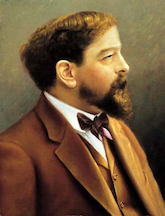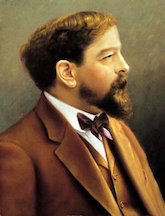
Today we commemorate the 152nd birthday of Claude Debussy. He came of age as music in Paris was going through a sea-change, pulling away from the influence of traditional (German and Italian) models and opening to a wide variety of new possibilities: Japanese art was all the rage, and an international exhibition in Paris introduced the young composer to Javanese gamelan music. New sounds from Russian composers, particularly Modest Mussorgsky, were heard in the French capital. Composers began to notice much earlier French music from the 1700s and earlier, which had been forgotten. Debussy also met Eric Satie, whose strange, uncategorizable music was a tonic to the younger composer. And of course, there was the unavoidable influence of Richard Wagner, the great German opera composer, whose skill in harmony and orchestration opened paths for most composers after him.
So maybe it’s not so strange that the young Debussy was a trailblazer who famously wrote: “Some people wish above all to conform to the rules. I wish only to render what I can hear. There is no theory. You have only to listen. Pleasure is the law.”
But Debussy was also connected to trends in the other arts in Paris, such as Impressionist painting and, most important, poets such as Paul Verlaine and Stephane Mallarme. His first masterwork for orchestra, Prelude to “The Afternoon of a Faun” (1891) was inspired by a Mallarme poem. And if the musical style he invented came to be known as “musical Impressionism” after the painters, you could say that they, like Debussy, were seeking to render what they could see. All the artistic movements in Paris at this time were changes in perspective that precipitated changes in technique. Discover fun facts about Debussy, listen to his music, watch videos, find links to websites and biographies at SFCV’s Composer Gallery page.

